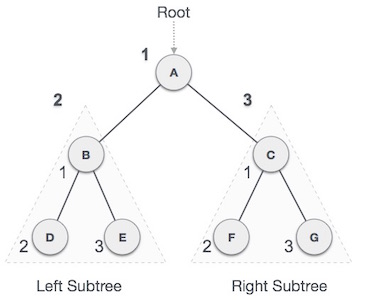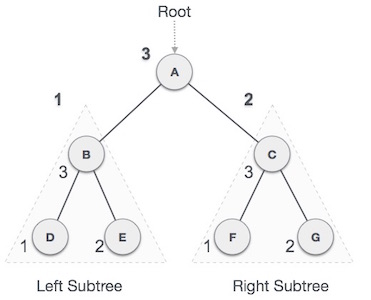Browse trees in data structures and algorithms
What is browsing trees?
Tree browsing is a process for accessing all the nodes of a tree and can also print the values of these nodes. Because all nodes are connected via edges (or links), we always start accessing from the root node. Therefore, we cannot randomly access any node in the tree. There are three methods that we can use to browse a tree:
Pre-order Traversal
Browse in order (In-order Traversal)
Post-order Traversal (Post-order Traversal)
Generally, we browse a tree to search or to locate the given element or key in the tree or to print all the values that the tree contains.
Browse middle order in binary tree
In this way, the left subtree is accessed first, then the root node and then the right subtree. You should always keep in mind that each node can represent a subtree.
If a binary tree is approved in the middle order, the result will be the key values arranged in ascending order.

In the example shown above, A is the root node. With the secondary order-approval method, we start from the root node A, move to the sub-tree to the left of the root node. Here, B is also approved in the way of secondary order approval. And the process continues until all the buttons have been accessed. The result of the central order approval for the above tree will be:
D → B → E → A → F → C → G
Algorithm for how to browse middle order
Duyệt cho tới khi tất cả các nút đều được duyệt: Bước 1 : Duyệt các cây con bên trái một cách đệ qui Bước 2 : Truy cập nút gốc Bước 3 : Duyệt các cây con bên phải một cách đệ qui
Browse money order in binary tree
In the way to browse the order in the binary tree, the root node is first browsed, then the left tree will be browsed and will eventually browse the right subtree.

In the example shown above, A is the root node. We start from A, and in the order of pre-order, we first access this root node A and then move to its child node on the left of B. B is also approved in the way of money order approval. And the process continues until all the buttons have been accessed. The result of how to approve the order of this tree will be:
A → B → D → E → C → F → G
Algorithm for how to browse the order
Duyệt cho tới khi tất cả các nút đều được duyệt: Bước 1 : Truy cập nút gốc Bước 2 : Duyệt các cây con bên trái một cách đệ qui Bước 3 : Duyệt các cây con bên phải một cách đệ qui
Browse post-order in binary trees
In the way of browsing the order in the binary tree, the root node of the tree will be last accessed, so you need to pay attention. First, we browse the tree on the left, then browse to the right subtree and finally browse to the root node.

In the example shown above, A is the root node. We start from A, and by way of post-order approval, we first access the subtree on the left B. B is also approved in the second order of post-order approval. And the process will continue until all the nodes have been accessed. The result of the post-order review of the above subtree will be:
D → E → B → F → G → C → A
Algorithm for post-order browsing
Duyệt cho tới khi tất cả các nút đều được duyệt: Bước 1 : Duyệt các cây con bên trái một cách đệ qui Bước 2 : Duyệt các cây con bên phải một cách đệ qui Bước 3 : Truy cập nút gốc.
According to Tutorialspoint
Previous lesson: Search algorithm by width
Next article: Binary Search Tree (Binary Search Tree)
 Binary Search Tree (Binary Search Tree)
Binary Search Tree (Binary Search Tree) Fibonacci series in Data Structures and Algorithms
Fibonacci series in Data Structures and Algorithms Algorithm for sharing (divide and conquer)
Algorithm for sharing (divide and conquer) What is Data Structure?
What is Data Structure? Environment settings in Data structures
Environment settings in Data structures Array data structure
Array data structure